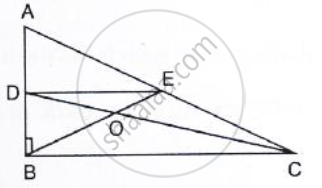Advertisements
Advertisements
प्रश्न
In the given figure, T is the midpoint of QR. Side PR of ΔPQR is extended to S such that R divides PS in the ratio 2:1. TV and WR are drawn parallel to PQ. Prove that T divides SU in the ratio 2:1 and WR = `(1)/(4)"PQ"`.
उत्तर
In ΔPQR,
T is the mid-point of QR and VT || PQ
So, V is the mid-point of PR.
Since R divides PR in the ratio 2 : 1 and PV = VR,
so, PV = PR = RS
Since R is the mid-point of SV and RW || VT,
W is the mid-point of ST.
Since V is the mid-point of PR and VT || PQ,
T is the mid-point of UW.
So, UT = TW = SW
⇒ T divides SU in the ratio 2 : 1
Also,
R and W are the midpoints SV and TS respectively.
⇒ WR = `(1)/(2)"VT"`
V and T are the mid-points of PR and UW respectively.
⇒ VT = `(1)/(2)"PQ"`
So, WR = `(1)/(2)(1/2 "PQ")`
⇒ WR = `(1)/(4)"PQ"`.
APPEARS IN
संबंधित प्रश्न
Show that the line segments joining the mid-points of the opposite sides of a quadrilateral bisect each other.
In Fig. below, triangle ABC is right-angled at B. Given that AB = 9 cm, AC = 15 cm and D,
E are the mid-points of the sides AB and AC respectively, calculate
(i) The length of BC (ii) The area of ΔADE.

ABCD is a kite having AB = AD and BC = CD. Prove that the figure formed by joining the
mid-points of the sides, in order, is a rectangle.
The side AC of a triangle ABC is produced to point E so that CE = AC. D is the mid-point of BC and ED produced meets AB at F. Lines through D and C are drawn parallel to AB which meet AC at point P and EF at point R respectively.
Prove that:
- 3DF = EF
- 4CR = AB
In triangle ABC ; D and E are mid-points of the sides AB and AC respectively. Through E, a straight line is drawn parallel to AB to meet BC at F.
Prove that BDEF is a parallelogram. If AB = 16 cm, AC = 12 cm and BC = 18 cm,
find the perimeter of the parallelogram BDEF.
In ΔABC, D, E, F are the midpoints of BC, CA and AB respectively. Find FE, if BC = 14 cm
In a parallelogram ABCD, E and F are the midpoints of the sides AB and CD respectively. The line segments AF and BF meet the line segments DE and CE at points G and H respectively Prove that: EGFH is a parallelogram.
D and E are the mid-points of the sides AB and AC of ∆ABC and O is any point on side BC. O is joined to A. If P and Q are the mid-points of OB and OC respectively, then DEQP is ______.
Show that the quadrilateral formed by joining the mid-points of the consecutive sides of a square is also a square.
Prove that the line joining the mid-points of the diagonals of a trapezium is parallel to the parallel sides of the trapezium.
